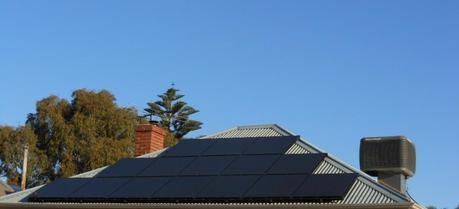 Rooftop solar panels can become a popular mass-market product. (Credit: Flickr @ Michael Coghlan http://www.flickr.com/photos/mikecogh/)
Rooftop solar panels can become a popular mass-market product. (Credit: Flickr @ Michael Coghlan http://www.flickr.com/photos/mikecogh/)What if solar energy could be developing as fast as consumer electronics? According to the researchers at KTH Royal Institute of Technology, Sweden, the mass market appeal of solar power could get a boost from design and packaging concepts that are being developed there.
A mobile app, a solar garden shed, a self-generation start-up kit and a video are among the concepts that can be developed into products, services or communications to attract consumers to the idea of making and storing their own energy.
Teo Enlund, a researcher and industrial designer at KTH is one of those working with the “User-friendly local electricity production” project, which is a part of the Green Leap initiative.

Teo Enlund (Credit: KTH Royal Institute of Technology)
Where “save the planet” was once the marketing pitch for solar energy, Enlund says the team’s ideas build on a more immediate appeal to the consumer—self-generation is a way to get free electricity.
“What you pay in the form of utility bills you pay on the solar cells instead,” he says.
The panels typically pay for themselves in 10 years; and after that—“You have free electricity,” he says. “When the solar panels come with a warranty of 25 years, it means 15 years of free electricity.”
One way the project seeks to encourage adoption is with hassle-free installation propositions. The solar garden shed, for example, can be used when one’s roof is not suitable for solar panels. These can also be designed to bypass typical municipal building codes, so the consumer could install it without seeking permits.
Aside from actual obstacles, adoption is also discouraged by imagined ones. “For example, there’s the widely-held belief that there must be beaming sunshine in order for solar panels to work. But, in fact, solar cells produce energy even on cloudy days,” said Enlund.
In addition to the garden shed, the team has proposed the idea of a mobile app that supports consumers through their entire progression toward energy self-sufficiency, from the point of being curious to having gone completely off the grid. Enlund says the app could be a source of inspiration and information, eventually displaying in real-time how much electricity each solar cell is producing.
Another concept is modular solar cells for public spaces, which is aimed at highlighting solar cells’ existence. Installing panels at such spots as bus stop shelters would help “normalize” solar energy. The All-in-One Starter is the kind of product that could sit alongside barbecue grills at the home improvement center or hardware store, says Enlund. “It can contain everything needed to get started.”
The project also suggested production of a video to promote the benefits of self-generation. “It’s about how to package locally-produced electricity,” Enlund says. “You can sell the concept as a way to save money, a savings of high and safe returns.”

